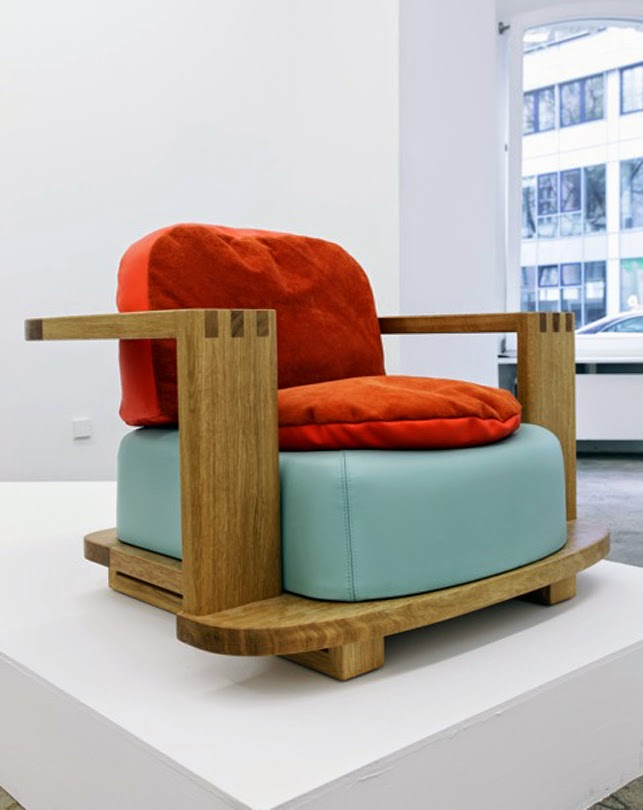"Poignantly the Fauteuil Cognac was in fact to be Laverrière’s very last furniture design drawn up especially for production by Silberkuppe and completed before she passed away in her sleep on January 1, 2011 just after her 101st birthday celebrated with champagne, family and friends."
"Janette Laverrière - Fauteuil Cognac (2010) solid oak, orange and pale blue leather and suede, available in an ‘artist’s edition’ of 8 produced by SILBERKUPPE Berlin pursuant to an exclusive license direct from the designer"
"Janette Laverrière - Fauteuil Cognac Combining an exquisitely crafted oiled oak frame with duotone, reversible suede and leather cushions, Janette Laverrière’s iconic Fauteuil Cognac (Cognac Chair, 2010) also has aesthetic roots in the designer’s earliest beginnings. In the 1930s, she was already an apprentice in the studio of legendary, luxury modernist furniture designer Jacques-Émile Ruhlmann. There the young interior architect and designer - herself the daughter of a distinguished Swiss architect Alphonse Laverrière - was trained in the well-drawn curve and the application of fine craftsmanship using quality materials. Subsequently in the pre-War years collaborative works with her first husband also evidenced her dexterity, foresight and originality – for instance, with her design low-lying seating-and-object-display dias for the circumference of a living room. After going it alone, as a radical designer in early postwar-Paris Laverrière’s design language matured and flourished against the odds as one of very few women alongside her near contemporaries such as Charlotte Perriand, or earlier Eileen Gray both of whom have reentered the canon only recently.
"In the same period Laverrière made her own a name for herself through the creative use of what were then unorthodox poor materials such as plywood and wrought iron, and her allowance of idiosyncratic decorative features implicitly questioning the then pervasive strictures of modernist design. But also because of her egalitarian social-political and feminist convictions which she brought directly to all of her work. Among hundreds of designs, in the 1960s she designed and produced the Whiskey chair, a piece which very late in life she confessed was an intentionally ambiguous homage to the habits of one of her former husbands. Nearly half a Century later, holding court to a loyal group of supporters and fans in her Marais apartment, surrounded by her work and plans (the majority of which are now on permanent loan to the Centre Pompidou), this grande dame of French design never stopped working. Sustenance in the form of delicate macaroons and port wine were on offer to the well-liked. From around 93 years of age Laverrière devoted herself for the last 8 years of her life to a series of ‘useless things’ – namely mirror objects titled Evocations intentionally on the cusp of art and design which entail a reflection back on the literary and political inspirations of her life. "
Janette Laverrière: Bibliothèque Tournante
An Exhibition Curated by Fionn Meade in cooperation with Nairy Baghramian and Silberkuppe with the support of the Cultural Services of the French Embassy in the U.S. as part of ART2
Hosted by: Thea Westreich Art Advisory Services 114 Greene Street, Fl. 2 New York, NY 10012
April 2 – 24, 2014, hours .
"The exhibition will present the work of Janette Laverrière (1909–2011), an interior architect and designer who lived and worked in Paris for the majority of her life. Exploring Laverrière’s role in crucial shifts in the history of 20th-century design, the exhibition will use her work as the starting point for a conversation around the politics of value as expressed by the aesthetics of architecture and design. The exhibition is the first presentation of her work in the U.S."
Bibliothèque Tournante revisits an exhibition originally conceived by Laverrière with artist Nairy Baghramian for the Schinkel Pavilion as part of the 5th Berlin Biennial (2008) entitled La lampe dans l’horloge. The exhibition will exhibit Laverrière’s prototypes, design multiples, and scenography, in particular her Evocations, a late grouping of mirrors that form part of what she termed her “useless objects series.” Producing commissioned mirror objects starting in 1936, Laverrière’s Evocations privileges allegorical content over utility. La Commune, hommage à Louise Michel (2001), for instance, with bullet holes perforating its lid, echoes the violence of the Paris Commune of 1871, while also performing an elegy to one of its key figures, the anarchist and proto-feminist Louise Michel. Within the exhibition Bibliothèque Tournante, the mirrors on the walls do not play according to the conventional rules of identification and refuse to return a stable representation. Instead, they offer subjective deportations into history, literature, and innuendo.
Bibliothèque Tournante will further consider the subjective positions and conceptualizing of value as it is proposed by Laverrière’s work in interior design, including through the gaps and resistances which arise from her own life and the historiography of her work. Born in 1909 in Switzerland, Janette Laverrière studied in Basel at the Allgemeine Gewerbeschule, where she learned the fundamentals of drawing and decoration. After training in her father’s architecture practice, she designed her first pieces of furniture in the late 1920s, and until 1945 collaborated on designs with Maurice Pré. Having for a short time joined the Communist Party in 1945, Laverrière’s professional life spanned crucial shifts in design thinking and politics in the postwar period and beyond. Having helped found the Front National des decorateurs (National Front for Decorators) and the Union des artistes decorateurs et createurs d’ensembles (Decorators Trade Union), both in 1944, Laverrière’s career continued to impact art, design, and social movements until her death in 2011.
text taken from here...
--------------



0 comments:
Post a Comment